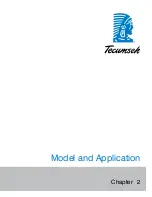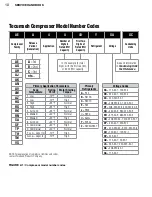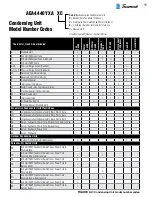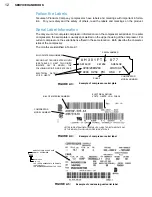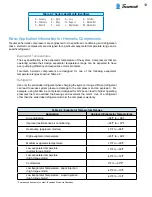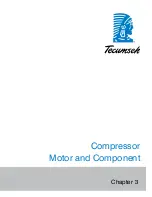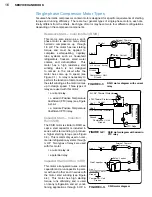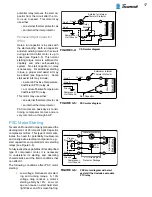
2
SERVICE HANDBOOK
Introduction
Tecumseh Products Company has prepared this handbook to assist service personnel in safely
working with refrigeration and air conditioning equipment that uses Tecumseh Products Company
hermetic compressors. It is not designed to replace the training required for professional service
personnel. It is also not intended to replace other information available from refrigeration and air
conditioning equipment manufacturers.
Trained Personnel Only
Servicing, repairing, and troubleshooting refrigeration and air conditioning systems should be done
only by those with the necessary knowledge, training, and equipment.
Terminal Venting and Electrocution
Improperly servicing, repairing, or troubleshooting a compressor can lead to electrocution or fire due
to terminal venting with ignition. Follow the precautions below to avoid serious injury or death from
electrocution or terminal venting with ignition.
Fire Hazard from Terminal Venting with Ignition
Oil and refrigerant can spray out of the compressor if one of
the terminal pins is ejected from the hermetic terminal. This
“terminal venting” can occur as a result of a ground fault
(also known as a short circuit to ground) in the compressor.
The oil and refrigerant spray from terminal venting can be
ignited by electricity and produce flames that can lead
to serious burns or death. See figures 1-1 through 1-3 for
details.
Terminal Venting and Electrocution Precautions
To reduce the risk of electrocution or serious burns or death from terminal venting with
ignition:
• Be alert for sounds of arcing (sizzling, sputtering or popping) inside the compressor.
IMMEDIATELY GET AWAY if you hear these sounds.
•
Disconnect ALL electrical power before removing the protective terminal cover.
Make
sure that all power legs are open. (NOTE: The system may have more
than one power supply.)
•
Never energize the system unless: 1) the protective terminal cover is
securely fastened, and 2) the compressor is properly connected to ground.
Figures 1-4 through 1-6 illustrate the different means of fastening protective
terminal covers.
• Never reset a breaker or replace a fuse without first checking for a ground fault
(a short circuit to ground).
An open fuse or tripped circuit breaker is a strong indication of a ground fault (also know
as a short circuit to ground). Use only a megohmmeter (“megger”) or a Hi-Potential Ground
tester (Hi-Pot) to check for a ground fault. A conventional ohmmeter will not reliably detect
a ground fault under certain circumstances. See the Service Handbook for more informa-
tion on checking for a ground fault. Also, always follow the megger or Hi-Pot manufacturer’s
procedures and safety rules.
If a ground fault does exist, keep the power off. WARNING! To avoid electric shock, electro-
cution, and terminal venting with ignition, do not energize a compressor that has a ground
!
WARNING
Never service, repair, or troubleshoot unless
you are qualified to perform these functions.
Improper servicing can lead to serious
injury or death from fire, electrical shock, or
explosion.
Summary of Contents for AH5540E
Page 1: ...Hermetic Compressor Service Handbook Wholesale Distribution North America...
Page 2: ......
Page 3: ...Hermetic Compressor Service Handbook Ann Arbor MI 48108 REV 3 11...
Page 4: ......
Page 8: ......
Page 9: ...Chapter 1 General Service Safety Precautions...
Page 16: ......
Page 17: ...Chapter 2 Model and Application...
Page 22: ......
Page 23: ...Chapter 3 Compressor Motor and Component...
Page 36: ......
Page 37: ...Chapter 4 Servicing...
Page 38: ...30 SERVICE HANDBOOK...
Page 79: ...71...
Page 80: ......
Page 81: ...Chapter 5 Installation and Replacement...
Page 96: ......
Page 97: ...Liquid refrigerant migration to compressor FIGURE 6 1 Chapter 6 Operation...
Page 108: ......
Page 109: ...Appendix...
Page 113: ...105 Reciprocating Compressor FIGURE A 2 Internal view of typical air conditioning compressor...
Page 118: ...110 SERVICE HANDBOOK Notes...
Page 119: ......

















